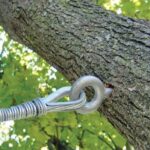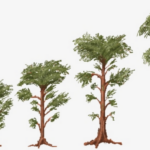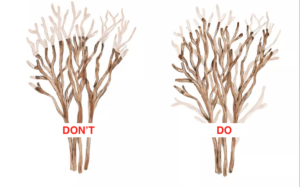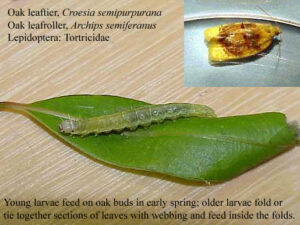Oak Leafrollers: Fascinating Caterpillars of Oak Trees

In the world of tree-dwelling insects, oak leafrollers are intriguing creatures. These small caterpillars, belonging to the Tortricidae family, have a special fondness for oak trees. In this article, we will explore the world of oak leafrollers, discussing their appearance, life cycle, behaviors, and impact on oak trees.
Identification and Appearance:
Oak leafrollers, scientifically known as Tortrix viridana, are caterpillars that can be challenging to spot due to their green color, which blends with oak leaves. They have cylindrical bodies, six true legs, and several pairs of prolegs that help them move around.
Life Cycle and Behavior:
Oak leafrollers begin their life cycle when adult moths lay eggs on the undersides of oak leaves in late spring or early summer. These eggs hatch into tiny caterpillars that immediately start feeding on the foliage. As they grow, the caterpillars exhibit a unique behavior called leaf rolling. They construct shelters by rolling and securing leaves together with silk threads. Within these rolled leaves, they continue to feed and find protection.
Feeding Habits and Impact on Oak Trees:
Oak leafrollers primarily eat oak leaves. They consume the leaf tissue inside their rolled shelters, leaving behind distinct patterns of chewed and skeletonized leaves. While individual leafrollers may not cause significant damage, a large population can lead to defoliation. Severe defoliation weakens oak trees, making them more susceptible to stress and negatively affecting their overall health.
Natural Predators and Control Measures:
Oak leafrollers have natural predators, such as birds, parasitic wasps, and predatory insects, which help keep their population in check. Bacterial and viral diseases can also impact leafroller populations. When it comes to controlling oak leafrollers, it is crucial to consider the health and balance of the ecosystem. If their population becomes problematic, measures like manually removing rolled leaves and caterpillars, targeted insecticides, or introducing natural enemies through biological control methods can be employed. Seeking guidance from certified arborists or pest management professionals is essential to determine the best approach that minimizes harm to beneficial insects and the environment.
Appreciating Nature’s Complexity:
Although oak leafrollers may be seen as pests due to their feeding habits, it is important to appreciate their role in the intricate web of nature. They are part of a diverse insect community that interacts with oak trees and contributes to the balance of the ecosystem. Understanding their life cycle, behaviors, and impact on oak trees fosters a deeper appreciation for the complexity of nature and the interconnectedness of its inhabitants.
Oak leafrollers, with their leaf-rolling habits and affinity for oak trees, offer a fascinating glimpse into the world of caterpillars and their relationship with the environment. While their feeding can lead to defoliation and impact oak tree health, it is crucial to approach their management with a balanced perspective, considering the overall dynamics of the ecosystem. Observing and studying these captivating creatures provides insights into the delicate balance of nature and the intricate relationships between insects and their host trees.




